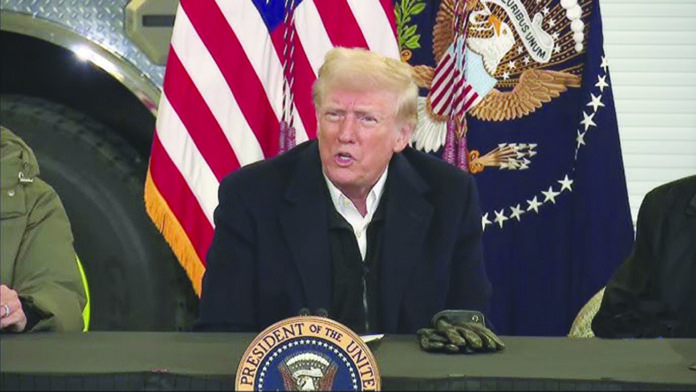On the Fourth of July, while Americans were watching fireworks light up the sky, President Donald Trump was lighting a fuse of a different kind. With the stroke of a pen, he signed the One Big Beautiful Bill Act- a name that sounds like a marketing gimmick for a Vegas casino- raising the U.S. federal debt ceiling by $5 trillion. That’s right: not million, not billion, but trillion, pushing the total debt to an eye-watering $41.1 trillion. Happy Birthday, America.
The irony is almost poetic. This bill isn’t just a number on a balance sheet- it’s a flashing red warning light on the dashboard of the global economy. And the real question isn’t if we hit the wall, but when.
Let’s take a step back.
In 2019, the U.S. debt stood at $23.2 trillion. Today? It’s soared to $36.1 trillion, and counting. That’s nearly a $13 trillion spike in just five years- more than the combined GDP of Japan and Germany. For a country that likes to lecture others on fiscal prudence, America’s borrowing binge makes a drunken sailor look disciplined.
What’s broken is not just the budget. It’s the whole idea of a debt ceiling. Originally intended as a check on reckless spending, it has become a ritual of political theatre- a rubber stamp wrapped in a partisan cage match. Since 1939, Congress has raised the debt ceiling 108 times. That’s once every nine months.
The debt ceiling is a political invention- once designed as a fiscal guardrail, now warped into a partisan tug-of-war. We’ve seen this circus before. Remember 2011? That standoff nearly triggered a default, tanked markets, and cost America its AAA credit rating. That eleventh-hour scramble nearly froze $62 billion in Social Security checks and crashed corporate bond markets. Global lending dropped off a cliff. And paradoxically, investors still ran toward US debt, like passengers flocking to the Titanic because it had better food.
But gravity always wins.
By May 2025, Moody’s downgraded US debt, stripping away its final triple-A rating. That’s right- the world’s biggest economy is now a credit risk. And here’s where it gets scary: interest payments on that debt are exploding. In fiscal 2024 alone, America paid $1.1 trillion just to service its debt. That’s more than the entire GDP of Indonesia.
Historically, we’ve been able to finesse this by relying on what economists call the “r-g” rule – as long as economic growth (g) outpaces interest rates (r), debt stays manageable. But that magic trick is fading. Growth has slowed, interest rates have climbed, and the math no longer works. The U.S. is now spending over 13 percent of its budget just to pay interest. That’s not investment – that’s treading water with lead shoes.
Because here’s the hard truth: empires don’t fall because of external invasions. They fall because they rot from the inside. And if we keep treating the global financial system like a casino where the house never loses- we may soon find out that the house can, in fact, go bankrupt.
The U.S. doesn’t just lack the will to repay its debt- it lacks the capacity. Put simply, maxed-out credit cards are being juggled by opening new ones. It’s fiscal hopscotch with no exit strategy.
Now, here’s where this shifts from being a domestic budget story to a global alarm bell.
The US dollar has long been the linchpin of the global financial system – the world’s reserve currency. Countries stockpile our debt not because they love us, but because they trust the stability of our institutions and the depth of our markets. Even in the darkest moments of 2008, US Treasuries were seen as a safe haven.
But safe havens can crumble. This past April, we witnessed a rare “triple kill”- simultaneous drops in U.S. stocks, bonds, and the dollar. Investors ran for the exits. The USA repurchased $10 billion in Treasuries in a single month- a historic move. Central banks slashed their US bond holdings by $1.2 trillion last year alone. Meanwhile, gold- that ancient fallback- soared to a post-Bretton Woods high. When gold rises and Treasuries fall, it means trust is eroding.
And now there is something called the Mar-a-Lago Agreement- a plan floated to issue “Century Bonds” in exchange for debt relief. Translation: the USA is toying with the idea of issuing IOUs that won’t mature until 2125. That’s not a plan. That’s a prayer.
Bridgewater founder Ray Dalio has repeatedly warned that we are entering a once-in-a-lifetime financial breakdown. He is not alone. The USA share of the global economy has dropped from 33 percent in 2000 to 25 percent today. The margin of error is shrinking fast.
This isn’t just about numbers. It’s about credibility. The Bretton Woods system that crowned the dollar king in 1944 is slowly unraveling. As more countries turn to digital currencies, regional alliances, and barter arrangements, the foundations of dollar dominance- and by extension, US power- are under siege.
And yet, Washington fiddles.
Look, I get it. Infrastructure is crumbling. Social programmes are under strain. Geopolitical competition with China is heating up. But the solution is not to keep maxing out the national credit card with glittery slogans and no repayment plan.
What we need is a new bipartisan compact- one that recognizes that fiscal discipline is not a constraint, but a form of strength. That understands real patriotism is about building something sustainable, not just signing whatever gets the crowd cheering.
Because here’s the hard truth: empires don’t fall because of external invasions. They fall because they rot from the inside. And if we keep treating the global financial system like a casino where the house never loses- we may soon find out that the house can, in fact, go bankrupt.























